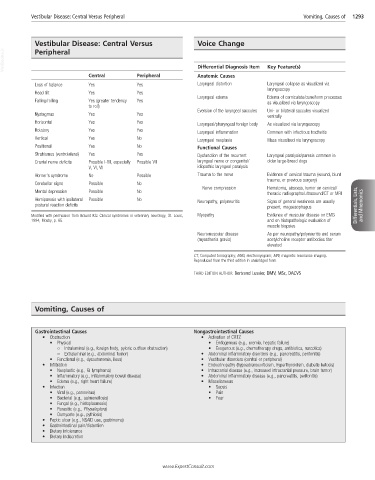Page 2564 - Cote clinical veterinary advisor dogs and cats 4th
P. 2564
Vestibular Disease: Central Versus Peripheral Vomiting, Causes of 1293
Vestibular Disease: Central Versus Voice Change
VetBooks.ir Peripheral Differential Diagnosis Item Key Feature(s)
Central Peripheral Anatomic Causes
Loss of balance Yes Yes Laryngeal distortion Laryngeal collapse as visualized via
laryngoscopy
Head tilt Yes Yes
Laryngeal edema Edema of corniculate/cuneiform processes
Falling/rolling Yes (greater tendency Yes as visualized via laryngoscopy
to roll)
Eversion of the laryngeal saccules Uni- or bilateral saccules visualized
Nystagmus Yes Yes ventrally
Horizontal Yes Yes Laryngeal/pharyngeal foreign body As visualized via laryngoscopy
Rotatory Yes Yes Laryngeal inflammation Common with infectious tracheitis
Vertical Yes No Laryngeal neoplasia Mass visualized via laryngoscopy
Positional Yes No Functional Causes
Strabismus (ventrolateral) Yes Yes Dysfunction of the recurrent Laryngeal paralysis/paresis common in
Cranial nerve deficits Possible I-XII, especially Possible VII laryngeal nerve or congenital/ older large-breed dogs
V, VI, VII idiopathic laryngeal paralysis
Horner’s syndrome No Possible Trauma to the nerve Evidence of cervical trauma (wound, blunt
trauma, or previous surgery)
Cerebellar signs Possible No
Nerve compression Hematoma, abscess, tumor on cervical/
Mental depression Possible No thoracic radiographs/ultrasound/CT or MRI
Hemiparesis with ipsilateral Possible No Neuropathy, polyneuritis Signs of general weakness are usually
postural reaction deficits present, megaesophagus Differentials, Lists, and Mnemonics
Modified with permission from Braund KG: Clinical syndromes in veterinary neurology, St. Louis, Myopathy Evidence of muscular disease on EMG
1994, Mosby, p. 65. and on histopathologic evaluation of
muscle biopsies
Neuromuscular disease As per neuropathy/polyneuritis and serum
(myasthenia gravis) acetylcholine receptor antibodies titer
elevated
CT, Computed tomography; EMG, electromyogram; MRI, magnetic resonance imaging.
Reproduced from the third edition in unabridged form.
THIRD EDITION AUTHOR: Bertrand Lussier, DMV, MSc, DACVS
Vomiting, Causes of
Gastrointestinal Causes Nongastrointestinal Causes
• Obstruction • Activation of CRTZ
• Physical • Endogenous (e.g., uremia, hepatic failure)
○ Intraluminal (e.g., foreign body, pyloric outflow obstruction) • Exogenous (e.g., chemotherapy drugs, antibiotics, narcotics)
○ Extraluminal (e.g., abdominal tumor) • Abdominal inflammatory disorders (e.g., pancreatitis, peritonitis)
• Functional (e.g., dysautonomia, ileus) • Vestibular disorders (central or peripheral)
• Infiltration • Endocrinopathy (hypoadrenocorticism, hyperthyroidism, diabetic ketosis)
• Neoplastic (e.g., GI lymphoma) • Intracranial disease (e.g., increased intracranial pressure, brain tumor)
• Inflammatory (e.g., inflammatory bowel disease) • Abdominal inflammatory disease (e.g., pancreatitis, peritonitis)
• Edema (e.g., right heart failure) • Miscellaneous
• Infection • Sepsis
• Viral (e.g., parvovirus) • Pain
• Bacterial (e.g., salmonellosis) • Fear
• Fungal (e.g., histoplasmosis)
• Parasitic (e.g., Physaloptera)
• Oomycete (e.g., pythiosis)
• Peptic ulcer (e.g., NSAID use, gastrinoma)
• Gastrointestinal pain/distention
• Dietary intolerance
• Dietary indiscretion
www.ExpertConsult.com

